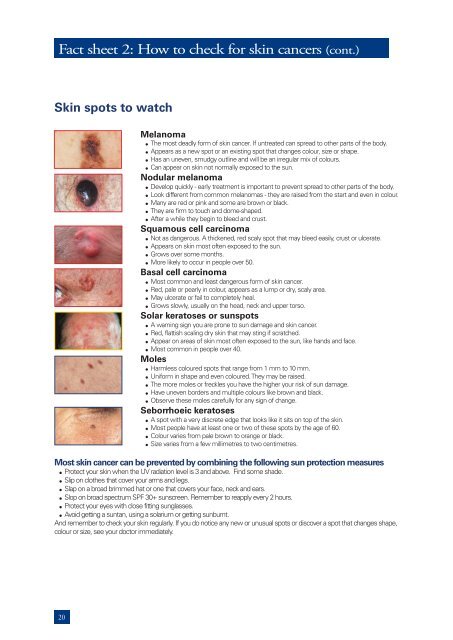Be SunSmart final print file.indd - Cancer Council SA
Be SunSmart final print file.indd - Cancer Council SA
Be SunSmart final print file.indd - Cancer Council SA
Create successful ePaper yourself
Turn your PDF publications into a flip-book with our unique Google optimized e-Paper software.
Fact sheet 2: How to check for skin cancers (cont.)<br />
Skin spots to watch<br />
20<br />
Melanoma<br />
l The most deadly form of skin cancer. If untreated can spread to other parts of the body.<br />
l Appears as a new spot or an existing spot that changes colour, size or shape.<br />
l Has an uneven, smudgy outline and will be an irregular mix of colours.<br />
l Can appear on skin not normally exposed to the sun.<br />
Nodular melanoma<br />
l Develop quickly - early treatment is important to prevent spread to other parts of the body.<br />
l Look different from common melanomas - they are raised from the start and even in colour.<br />
l Many are red or pink and some are brown or black.<br />
l They are firm to touch and dome-shaped.<br />
l After a while they begin to bleed and crust.<br />
Squamous cell carcinoma<br />
l Not as dangerous. A thickened, red scaly spot that may bleed easily, crust or ulcerate.<br />
l Appears on skin most often exposed to the sun.<br />
l Grows over some months.<br />
l More likely to occur in people over 50.<br />
Basal cell carcinoma<br />
l Most common and least dangerous form of skin cancer.<br />
l Red, pale or pearly in colour, appears as a lump or dry, scaly area.<br />
l May ulcerate or fail to completely heal.<br />
l Grows slowly, usually on the head, neck and upper torso.<br />
Solar keratoses or sunspots<br />
l A warning sign you are prone to sun damage and skin cancer.<br />
l Red, flattish scaling dry skin that may sting if scratched.<br />
l Appear on areas of skin most often exposed to the sun, like hands and face.<br />
l Most common in people over 40.<br />
Moles<br />
l Harmless coloured spots that range from 1 mm to 10 mm.<br />
l Uniform in shape and even coloured. They may be raised.<br />
l The more moles or freckles you have the higher your risk of sun damage.<br />
l Have uneven borders and multiple colours like brown and black.<br />
l Observe these moles carefully for any sign of change.<br />
Seborrhoeic keratoses<br />
l A spot with a very discrete edge that looks like it sits on top of the skin.<br />
l Most people have at least one or two of these spots by the age of 60.<br />
l Colour varies from pale brown to orange or black.<br />
l Size varies from a few millimetres to two centimetres.<br />
Most skin cancer can be prevented by combining the following sun protection measures<br />
l Protect your skin when the UV radiation level is 3 and above. Find some shade.<br />
l Slip on clothes that cover your arms and legs.<br />
l Slap on a broad brimmed hat or one that covers your face, neck and ears.<br />
l Slop on broad spectrum SPF 30+ sunscreen. Remember to reapply every 2 hours.<br />
l Protect your eyes with close fitting sunglasses.<br />
l Avoid getting a suntan, using a solarium or getting sunburnt.<br />
And remember to check your skin regularly. If you do notice any new or unusual spots or discover a spot that changes shape,<br />
colour or size, see your doctor immediately.<br />
how to check for skin cancers.in2 2 16/08/2006 1:46:39 PM



